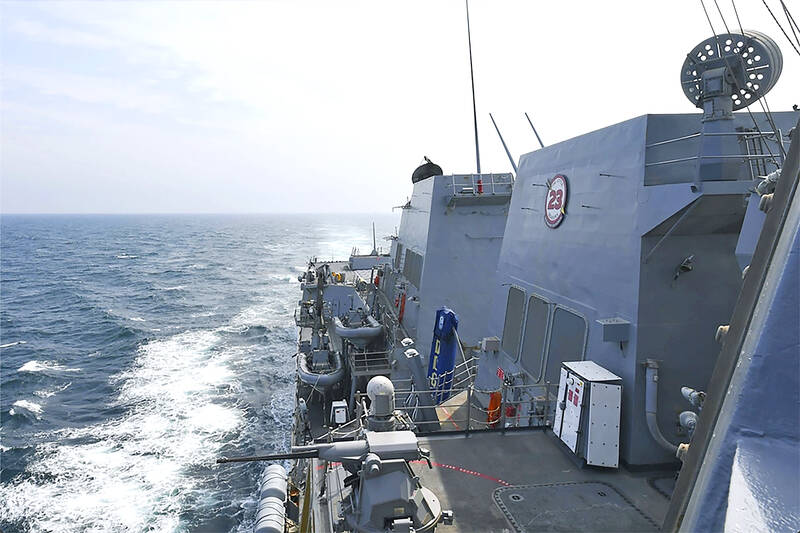Current and former US military leaders are increasingly urging Washington to abandon its long-standing policy of “strategic ambiguity” to counter Beijing’s attempts to change the “status quo” in the Taiwan Strait, Nikkei Asia reported on Friday.
“Strategic ambiguity has had its day and it’s time to move to strategic clarity,” retired admiral Harry Harris, former commander of the US Indo-Pacific Command, told the magazine on the sidelines of the Global Energy Security Talks in Tokyo.
“The Taiwan Relations Act calls for a peaceful resolution and calls for the status quo,” Harris said. “China has changed the status quo and is acting belligerently with regard to Taiwan, so that obligates us to do certain things to help Taiwan.”

Photo: Mass Communication Specialist Third-class Ismael Martinez, US Navy via AP
The act stipulates that peace and stability in the region are in the “political, security and economic interests of the US,” and that the US president and the US Congress must take “appropriate action” should those interests be put at risk, he said.
US President Joe Biden has said four times that his administration would defend Taiwan, Harris said.
“We should take him at his word. He is our commander-in-chief,” he said.
Harris’ successors as commanders of the US Indo-Pacific Command, retired admirals Philip Davidson and John Aquilino, have both testified in Congress that strategic ambiguity had served the US well, Nikkei Asia reported.
However, Commander of the Indo-Pacific Command Admiral Samuel Paparo did not defend the policy of ambiguity or use the term to describe the US’ stance toward Taiwan during his confirmation hearing earlier this year, the magazine said.
“There is no ambiguity for the joint force,” he said. “There is just the mission clarity contained within the Taiwan Relations Act that the [US] Department [of Defense] will aid Taiwan’s ability to defend itself.”
Asked if he meant preparing US regional forces under his command for “every potential,” including combat, Paparo said: “Yes sir. Clarity and mission focus.”
Separately, he told Nikkei Asia during an interview last month that the US closely observed Beijing’s military drills conducted shortly after President William Lai’s (賴清德) inauguration.
“We watched it. We took note. We learned from it. And they helped us prepare for the future,” he said.
He said he was confident the US and its allies would defeat China in a conflict.
However, Jeremy Furchtgott, director of Washington-based consultancy Baron Public Affairs and leader of the firm’s China practice, said that embracing strategic clarity risks forcing China into a corner.
“If the goal is conflict, the US should signal clarity. If the goal is to freeze the current situation, there should be ambiguity and mixed messages,” he told Nikkei Asia.

A magnitude 7.0 earthquake struck off Yilan at 11:05pm yesterday, the Central Weather Administration (CWA) said. The epicenter was located at sea, about 32.3km east of Yilan County Hall, at a depth of 72.8km, CWA data showed There were no immediate reports of damage. The intensity of the quake, which gauges the actual effect of a seismic event, measured 4 in Yilan County area on Taiwan’s seven-tier intensity scale, the data showed. It measured 4 in other parts of eastern, northern and central Taiwan as well as Tainan, and 3 in Kaohsiung and Pingtung County, and 2 in Lienchiang and Penghu counties and 1

A car bomb killed a senior Russian general in southern Moscow yesterday morning, the latest high-profile army figure to be blown up in a blast that came just hours after Russian and Ukrainian delegates held separate talks in Miami on a plan to end the war. Kyiv has not commented on the incident, but Russian investigators said they were probing whether the blast was “linked” to “Ukrainian special forces.” The attack was similar to other assassinations of generals and pro-war figures that have either been claimed, or are widely believed to have been orchestrated, by Ukraine. Russian Lieutenant General Fanil Sarvarov, 56, head

FOREIGN INTERFERENCE: Beijing would likely intensify public opinion warfare in next year’s local elections to prevent Lai from getting re-elected, the ‘Yomiuri Shimbun’ said Internal documents from a Chinese artificial intelligence (AI) company indicated that China has been using the technology to intervene in foreign elections, including propaganda targeting Taiwan’s local elections next year and presidential elections in 2028, a Japanese newspaper reported yesterday. The Institute of National Security of Vanderbilt University obtained nearly 400 pages of documents from GoLaxy, a company with ties to the Chinese government, and found evidence that it had apparently deployed sophisticated, AI-driven propaganda campaigns in Hong Kong and Taiwan to shape public opinion, the Yomiuri Shimbun reported. GoLaxy provides insights, situation analysis and public opinion-shaping technology by conducting network surveillance

‘POLITICAL GAME’: DPP lawmakers said the motion would not meet the legislative threshold needed, and accused the KMT and the TPP of trivializing the Constitution The Legislative Yuan yesterday approved a motion to initiate impeachment proceedings against President William Lai (賴清德), saying he had undermined Taiwan’s constitutional order and democracy. The motion was approved 61-50 by lawmakers from the main opposition Chinese Nationalist Party (KMT) and the smaller Taiwan People’s Party (TPP), who together hold a legislative majority. Under the motion, a roll call vote for impeachment would be held on May 19 next year, after various hearings are held and Lai is given the chance to defend himself. The move came after Lai on Monday last week did not promulgate an amendment passed by the legislature that